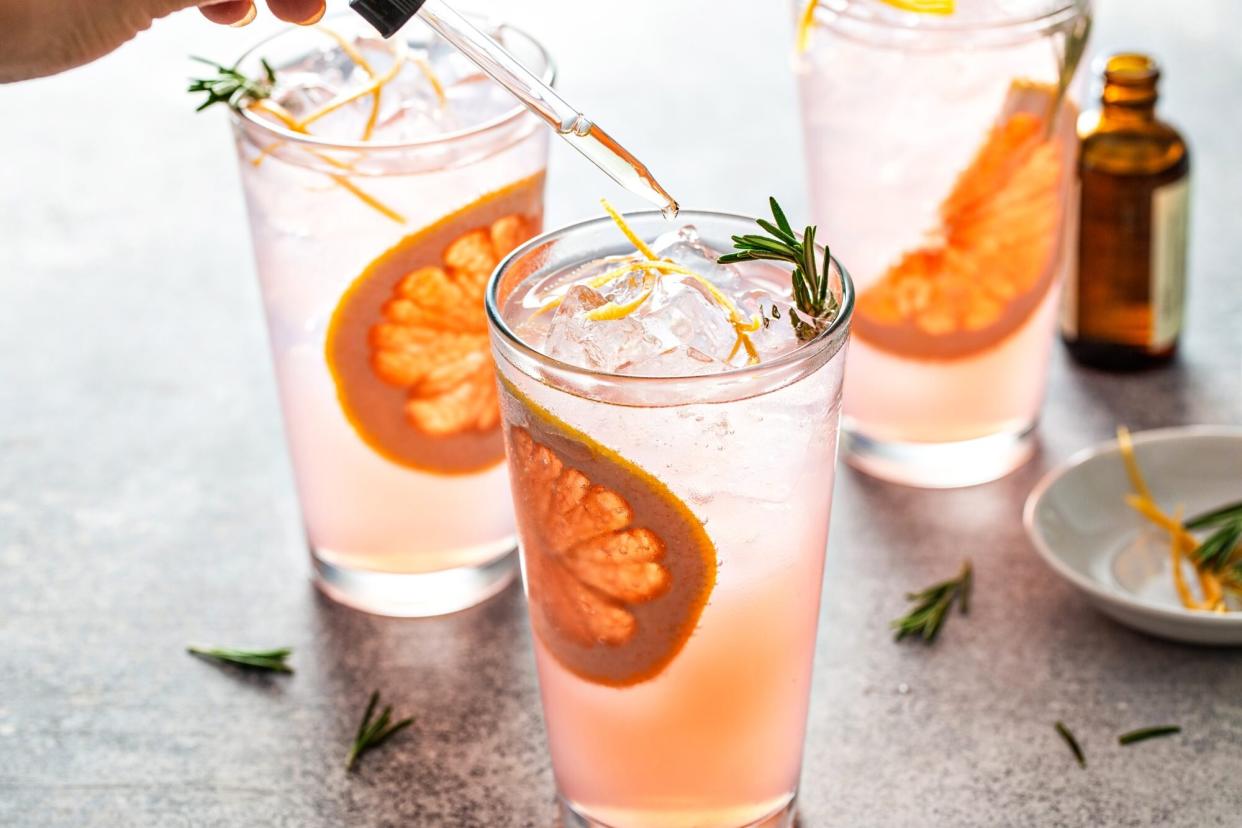Bitters Are the Secret to a Better Cocktail—Here's How to Use Them

Sergiu Creanga / 500px / GETTY IMAGES
Beloved by bartenders and cocktail enthusiasts for generations, bitters make drinks taste better. Ranging from age-old concoctions to new lively iterations, these potent potions enhance your favorite beverage, be it a seltzer or a martini, like no other ingredient. So, what exactly are bitters and what's the best way to use them? We got the lowdown on this beguiling category of elixirs from a bartender and two top bitters makers.
Related: How the Shape of Your Glass Impacts Your Drink
What Are Bitters?
Sold in small bottles, bitters are traditionally made by macerating multiple botanicals in spirits before filtering and bottling them. The combination of ingredients lends many classic cocktails their distinctive, recognizable taste. "I think of bitters as the spice rack of the cocktail world," says Sammi Katz, writer, bartender, and author of Cocktails in Color: A Spirited Guide to the Art and Joy of Drinkmaking. "They are neutral, high-proof spirits loaded with herbs, bark, spices, and roots, and are commonly used as a flavoring agent in cocktails."
How They Are Made
Hella Cocktail Co. for instance, crafts its alcohol-based bitters—which run the flavor gamut from classic aromatic bitters and orange bitters to smoked chili bitters—with whole spices and fruit peel, says Eddie Simeón, co-founder and CMO of the New York-based company. "At Hella, we prefer using high-proof alcohol because of its clean flavor profile," he says, adding that the brand's bitters never contain unnatural preservatives or colors.
But there's more than one way to make bitters. Some manufacturers bypass botanicals, blending commercial liquid extracts that are passed off as 'bitters'—a category that might warrant a hard pass.
And other companies forgo alcohol altogether. "We use non-GMO vegetable-based glycerin as our base instead of a high-proof spirit. The end result is 0 percent ABV bitters," says Christa Cotton, CEO of El Guapo in New Orleans. El Guapo's bitters use spices, nuts, fruits, seeds, herbs, fruits, roots, and vegetables, with many formulations boasting a Southern accent. "Whether it's the chicory in our flagship coffee and pecan bitters, or experimenting with raw sugar cane, peaches, satsumas, and mirlitons, I'm always testing recipes with our team and looking for innovative ways to use traditional Southern ingredients," says Cotton.
How to Use Them
Bitters aren't just for cocktails—they elevate non-alcoholic beverages, too.
Cocktails
Bitters are intense, so all it takes is a dash or two to magically marry the other ingredients in a cocktail. "Keep in mind that you only use a minimal amount of bitters to impart lots of flavors," says Simeón. "Bitters balance the other flavors in a drink—sweet, bright, spicy—and bind them into something more cohesive."
They also add a certain oomph that other ingredients simply can't match. "Bitters are a great way to add depth and complexity to cocktails," says Katz."I like using bitters as a little something extra in my cocktails. When I don't want to add additional sugar in the form of a sweetener or liquor, bitters are a good way to get another punch of flavor," she says.
Non-Alcoholic Drinks
Bbitters make non-alcoholic beverages more sophisticated and memorable, says Simeón—but Cotton considers bitters multi-purpose. "They highlight different expressions within spirits and add flavor to plain club soda," she says, noting that even tea and coffee can benefit from a splash of bitters. "We also use them to bake and in various cooking recipes, too," says Cotton. The experts' advice? When using bitters, let your imagination be your guide.
A Little History
Bitters are hardly a new ingredient, as any visitor to The New Orleans Pharmacy Museum might discover. "You'll learn that bitters were once marketed as a digestive aid, and sold as patent medicines before eventually becoming a key ingredient in many classic cocktails," says Cotton.
Peychaud's Bitters
Pharmacist Antoine Amédée Peychaud, for example, created Peychaud's aromatic bitters in New Orleans in 1834 as a medicinal tonic, and also mixed his invention with brandy and other spirits. In time, Peychaud's bitters took pride of place in the city's quintessential tipple, the Sazarec.
Angostura Bitters
Angostura aromatic bitters also started out as a health-minded elixir, devised by Dr. Johann Siegert in 1824, in Angostura, Venezuela, to ease stomach troubles. His sons took the tincture to Trinidad, and its use in cocktails, including the Manhattan and the Old-Fashioned, continued to mushroom. "Angostura bitters are your classic, aromatic bitters," says Katz. "They're spicy and bitter, with hints of gentian root, clove, and cinnamon. The recipe is a closely guarded secret, though, so we can't know for sure what's in there."
The Cocktail Revolution
Arriving on the cusp of the Golden Age of Cocktails, when Americans began to thirst for innovative mixed drinks, bitters soon became integral to cocktail culture, and are now a time-honored staple for mixologists everywhere.
Old and New Ways to Use Bitters
Some classic applications of bitters still endure. Katz, for example, likes to make martinis with orange bitters, a bartender's touch reminiscent of the original martini recipes of the late 19th century, when the cocktail regularly included the ingredient.
Simeón takes orange bitters in a different direction, using them to supplement orange liqueur in a classic margarita, resulting in a rich citrus taste. Whatever the drink, he encourages unadulterated experimentation with bitters. Through trial and error, you're sure to land on a fresh combo. "So play around!" he says.

